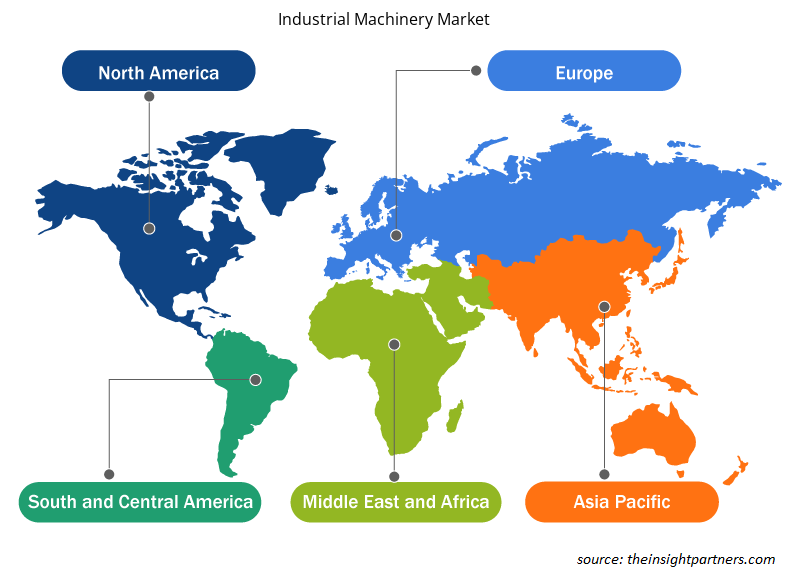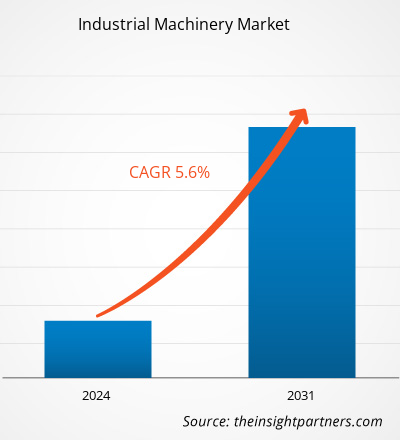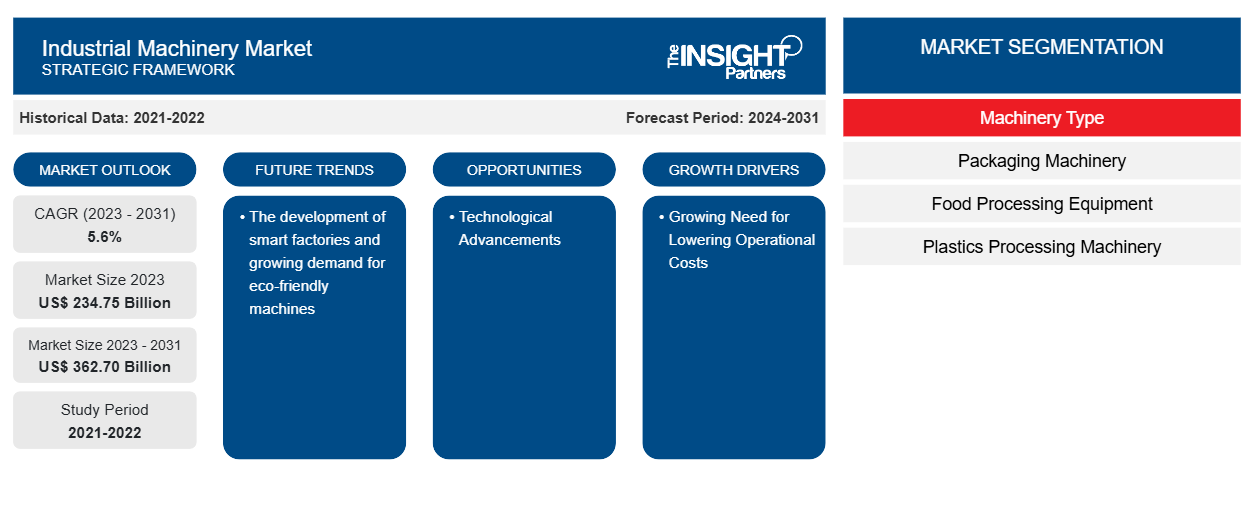Der Markt für Industriemaschinen soll von 234,75 Milliarden US-Dollar im Jahr 2023 auf 362,70 Milliarden US-Dollar im Jahr 2031 anwachsen. Der Markt soll zwischen 2023 und 2031 eine durchschnittliche jährliche Wachstumsrate (CAGR) von 5,6 % verzeichnen. Die Entwicklung intelligenter Fabriken und die wachsende Nachfrage nach umweltfreundlichen Maschinen dürften weiterhin ein wichtiger Trend auf dem Markt für Industriemaschinen bleiben.
Marktanalyse für Industriemaschinen
Der Markt für Industriemaschinen wächst rasant, da die Notwendigkeit zur Senkung der Betriebskosten zunimmt und Industriemaschinen zunehmend in der Automobil-, Lebensmittel- und Getränkeindustrie, der Pharmaindustrie, der Fertigungsindustrie und anderen Branchen eingesetzt werden. Der Markt wächst stetig, angetrieben durch die zunehmende Urbanisierung und industrielle Automatisierung . Darüber hinaus bieten technologische Fortschritte und die Integration von KI und 3D-Digitaldrucktechnologie lukrative Möglichkeiten für Marktwachstum.
Marktübersicht für Industriemaschinen
Unter Industriemaschinen versteht man alle mechanischen, elektrischen oder elektronischen Geräte, die dazu bestimmt sind, eine bestimmte Funktion auszuführen und ein bestimmtes Ergebnis zu erzielen. Hersteller in Fertigungsanlagen verwenden diese Maschinen zum Schneiden, Formen, Laminieren oder Koordinieren von Produktionsprozessen. Industriemaschinen spielen eine entscheidende Rolle bei der Unterstützung industrieller Aktivitäten weltweit. Die zunehmende Digitalisierung, technologische Fortschritte und Industrie 4.0-Initiativen schaffen Chancen auf dem Markt.
Passen Sie diesen Bericht Ihren Anforderungen an
Sie erhalten kostenlos individuelle Anpassungen an jedem Bericht, einschließlich Teilen dieses Berichts oder einer Analyse auf Länderebene, eines Excel-Datenpakets sowie tolle Angebote und Rabatte für Start-ups und Universitäten.
-
Holen Sie sich die wichtigsten Markttrends aus diesem Bericht.Dieses KOSTENLOSE Beispiel umfasst eine Datenanalyse von Markttrends bis hin zu Schätzungen und Prognosen.
Treiber und Chancen auf dem Industriemaschinenmarkt
Wachsender Bedarf zur Senkung der Betriebskosten treibt den Markt an
Niedrigere Betriebskosten führen zu höheren Margen, sodass Unternehmen ihr Produktangebot diversifizieren und durch Kostensenkungsmaßnahmen neue Märkte erschließen können. Der wachsende Bedarf der Unternehmen an niedrigeren Betriebskosten erhöht die Nachfrage nach technologisch fortschrittlichen Maschinen. Hersteller integrieren IoT-Anwendungen in diese Geräte, um erweiterte Dienste wie Fernüberwachung, zentrale Feedbacksysteme und andere Funktionen bereitzustellen. Darüber hinaus setzen Hersteller auch verbesserte Sensoren, mobile Apps und eingebettete Software ein, um ihre Betriebsabläufe zu optimieren, indem sie die Gesamtbetriebskosten senken, was den Markt antreibt.IoT applications into these devices to provide enhanced services such as remote monitoring, central feedback systems, and other features. Moreover, manufacturers are also adopting enhanced sensors, mobile apps, and embedded software to streamline their operational processes by lowering the overall business costs is driving the market.
Technologischer Fortschritt – eine Chance auf dem Markt für Industriemaschinen
Es wird erwartet, dass schnelle technologische Fortschritte im Prognosezeitraum die Innovation auf dem Markt für Industriemaschinen vorantreiben werden. Darüber hinaus setzen Fertigungsindustrien fortschrittliche Technologien wie künstliche Intelligenz, 3D-Druck und Big-Data-Analyse ein, um Betriebskosten zu senken, die Produktivität zu verbessern und höhere Gewinne zu erzielen. Die potenzielle Integration von 3D-Druck und KI-Technologie schafft jedoch Wachstumschancen für internationale und inländische Akteure auf dem Markt für Industriemaschinen.
Segmentierungsanalyse des Marktberichts für Industriemaschinen
Wichtige Segmente, die zur Ableitung der Marktanalyse für Industriemaschinen beigetragen haben, sind die Maschinentypen.
- Basierend auf dem Maschinentyp ist der Markt für Industriemaschinen in Verpackungsmaschinen, Lebensmittelverarbeitungsgeräte, Maschinen zur Kunststoffverarbeitung, Werkzeugmaschinen zur Metallumformung und Holzbearbeitungsmaschinen unterteilt.
- Das Segment Verpackungsmaschinen ist in Abfüllmaschinen, Palettiermaschinen, Etikettiermaschinen, Verpackungsmaschinen und andere unterteilt. Das Segment Lebensmittelverarbeitungsgeräte ist in Schneide- und Würfelschneidemaschinen, Extruder, Dosier- und Mischmaschinen, Lager- und Kühlgeräte und andere unterteilt. Das Segment Kunststoffverarbeitungsmaschinen ist in Inspektionsformmaschinen, Blasformmaschinen, Extrusionsformmaschinen und andere unterteilt. Das Segment Metallformmaschinen ist in Druckmaschinen, Biegemaschinen, Gussmaschinen, Stanzmaschinen und andere unterteilt. Das Segment Holzbearbeitungsmaschinen ist in Drehmaschinen, Schleifmaschinen, Bandsägemaschinen und andere unterteilt.
Marktanteilsanalyse für Industriemaschinen nach Geografie
Der geografische Umfang des Marktberichts für Industriemaschinen ist hauptsächlich in fünf Regionen unterteilt: Nordamerika, Asien-Pazifik, Europa, Naher Osten und Afrika sowie Südamerika/Süd- und Mittelamerika.
Gemessen am Umsatz hatte der asiatisch-pazifische Raum den größten Marktanteil im Bereich Industriemaschinen, was auf die steigenden Investitionen in Infrastrukturprojekte wie Transport, Energie und Stadtentwicklung zurückzuführen ist. Der wachsende Bedarf an einer Vielzahl von Industriegeräten wie Baumaschinen, Erdbewegungsmaschinen und Materialtransportgeräten treibt den Markt in der Region an.earthmoving equipment, and material handling equipment, is fueling the market in the region.
Regionale Einblicke in den Markt für Industriemaschinen
Die regionalen Trends und Faktoren, die den Markt für Industriemaschinen im Prognosezeitraum beeinflussen, wurden von den Analysten von Insight Partners ausführlich erläutert. In diesem Abschnitt werden auch Marktsegmente und Geografien für Industriemaschinen in Nordamerika, Europa, im asiatisch-pazifischen Raum, im Nahen Osten und Afrika sowie in Süd- und Mittelamerika erörtert.

- Erhalten Sie regionale Daten zum Industriemaschinenmarkt
Umfang des Marktberichts für Industriemaschinen
| Berichtsattribut | Details |
|---|---|
| Marktgröße im Jahr 2023 | 234,75 Milliarden US-Dollar |
| Marktgröße bis 2031 | 362,70 Milliarden US-Dollar |
| Globale CAGR (2023 - 2031) | 5,6 % |
| Historische Daten | 2021-2022 |
| Prognosezeitraum | 2024–2031 |
| Abgedeckte Segmente |
Nach Maschinentyp
|
| Abgedeckte Regionen und Länder |
Nordamerika
|
| Marktführer und wichtige Unternehmensprofile |
|
Marktteilnehmerdichte für Industriemaschinen: Auswirkungen auf die Geschäftsdynamik verstehen
Der Markt für Industriemaschinen wächst rasant, angetrieben durch die steigende Nachfrage der Endverbraucher aufgrund von Faktoren wie sich entwickelnden Verbraucherpräferenzen, technologischen Fortschritten und einem größeren Bewusstsein für die Vorteile des Produkts. Mit steigender Nachfrage erweitern Unternehmen ihr Angebot, entwickeln Innovationen, um die Bedürfnisse der Verbraucher zu erfüllen, und nutzen neue Trends, was das Marktwachstum weiter ankurbelt.
Die Marktteilnehmerdichte bezieht sich auf die Verteilung der Firmen oder Unternehmen, die in einem bestimmten Markt oder einer bestimmten Branche tätig sind. Sie gibt an, wie viele Wettbewerber (Marktteilnehmer) in einem bestimmten Marktraum im Verhältnis zu seiner Größe oder seinem gesamten Marktwert präsent sind.
Die wichtigsten auf dem Markt für Industriemaschinen tätigen Unternehmen sind:
- AB Electrolux
- Alfa Laval
- AMADA CO., LTD.
- GEA Group
- HAITIAN INTERNATIONAL
- MITSUBISHI HEAVY INDUSTRIES, LTD
Haftungsausschluss : Die oben aufgeführten Unternehmen sind nicht in einer bestimmten Reihenfolge aufgeführt.

- Überblick über die wichtigsten Akteure auf dem Markt für Industriemaschinen
Neuigkeiten und aktuelle Entwicklungen zum Industriemaschinenmarkt
Der Markt für Industriemaschinen wird durch die Erhebung qualitativer und quantitativer Daten nach Primär- und Sekundärforschung bewertet, die wichtige Unternehmensveröffentlichungen, Verbandsdaten und Datenbanken umfasst. Im Folgenden finden Sie eine Liste der Entwicklungen auf dem Markt für Industriemaschinen und Strategien:
- Im November 2022 brachte Ingersoll Rand den 135MAX Heavy Duty Air Hammer für den industriellen Einsatz auf den Markt. Der 135MAX HD Air Hammer ist der Drucklufthammer der nächsten Generation, der auf der Grundlage des 119MAX aufbaut und unglaubliche Leistung und Kraft zu einem erschwinglichen Preis bietet – und gleichzeitig einen fein abgestimmten, federnden Auslöser nutzt, der von den legendären Ingersoll Rand-Schlagschraubern inspiriert ist, für mehr Präzision und noch bessere Ergebnisse. (Quelle: Ingersoll Rand, Pressemitteilung, 2022)
Marktbericht zum Industriemaschinenbau – Umfang und Ergebnisse
Der Bericht „Marktgröße und Prognose für Industriemaschinen (2021–2031)“ bietet eine detaillierte Analyse des Marktes, die die folgenden Bereiche abdeckt:
- Marktgröße und Prognose auf globaler, regionaler und Länderebene für alle wichtigen Marktsegmente, die im Rahmen des Projekts abgedeckt sind
- Marktdynamik wie Treiber, Beschränkungen und wichtige Chancen
- Wichtige Zukunftstrends
- Detaillierte PEST/Porters Five Forces- und SWOT-Analyse
- Globale und regionale Marktanalyse mit wichtigen Markttrends, wichtigen Akteuren, Vorschriften und aktuellen Marktentwicklungen
- Branchenlandschaft und Wettbewerbsanalyse, einschließlich Marktkonzentration, Heatmap-Analyse, prominenten Akteuren und aktuellen Entwicklungen
- Detaillierte Firmenprofile
- Historische Analyse (2 Jahre), Basisjahr, Prognose (7 Jahre) mit CAGR
- PEST- und SWOT-Analyse
- Marktgröße Wert/Volumen – Global, Regional, Land
- Branchen- und Wettbewerbslandschaft
- Excel-Datensatz
Aktuelle Berichte
Erfahrungsberichte
Grund zum Kauf
- Fundierte Entscheidungsfindung
- Marktdynamik verstehen
- Wettbewerbsanalyse
- Kundeneinblicke
- Marktprognosen
- Risikominimierung
- Strategische Planung
- Investitionsbegründung
- Identifizierung neuer Märkte
- Verbesserung von Marketingstrategien
- Steigerung der Betriebseffizienz
- Anpassung an regulatorische Trends























 Kostenlose Probe anfordern für - Markt für Industriemaschinen
Kostenlose Probe anfordern für - Markt für Industriemaschinen